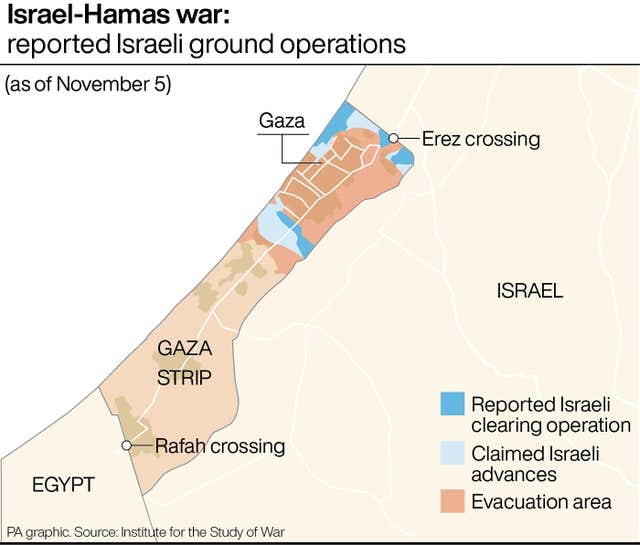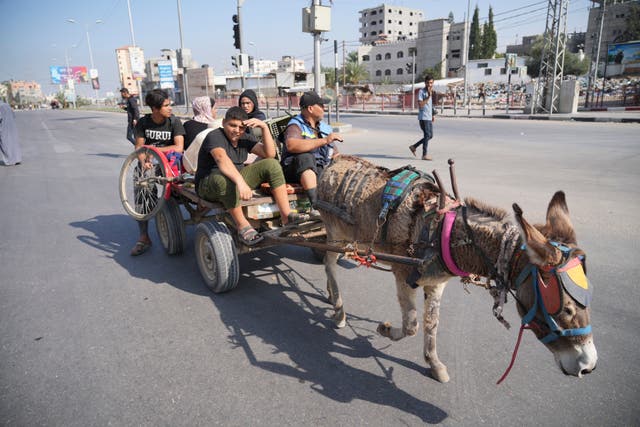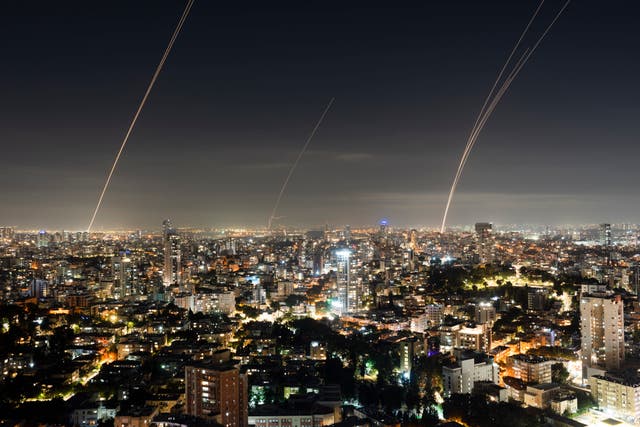Israeli forces severed northern Gaza from the rest of the besieged territory and pounded it with intense airstrikes overnight, setting the stage for an expected push into the dense confines of Gaza City and an even bloodier phase of the month-old war.
Already, the Palestinian death toll passed 10,000, the Health Ministry in Hamas-run Gaza said on Monday.
The ministry does not distinguish between fighters and civilians.
Some 1,400 Israelis have died, mostly civilians killed in the October 7 incursion by Hamas that started the war.
The figures mark a grim milestone in what has quickly become the deadliest round of Israeli-Palestinian violence since Israel’s establishment 75 years ago, with no end in sight as Israel vows to remove Hamas from power and crush its military capabilities.
Casualties are only likely to rise as the war turns to close urban combat.
Troops are expected to enter Gaza City soon, Israeli media reported, and Palestinian militants who have had years to prepare are likely to fight street by street, launching ambushes from a vast network of tunnels.
The Israeli military said late Sunday that it had cut off northern Gaza from the south, calling it a “significant stage” in the war.
On Monday, it said that aircraft struck 450 targets overnight and ground troops took over a Hamas compound.
A one-way corridor for residents to flee south remains available, according to the military, for the hundreds of thousands of Palestinians who remain in Gaza City and other parts of the north.
In recent days, airstrikes have hit UN facilities where thousands are sheltering, as well as hospitals, which have been overwhelmed by wounded and are running low on power and supplies.

A strike early on Monday hit the roof of Gaza City’s Shifa Hospital, killing a number of displaced people sheltering on its top floor and destroying solar panels, according to Mohamed Zaqout, the general manager of all hospitals in Gaza.
The solar panels had been helping to keep power on in the facility, which has been reduced to using one generator because of lack of fuel.
Heavy Israeli bombardment overnight also hit the Shati refugee camp, a densely built-up district on the Mediterranean coast adjacent to central Gaza City. Palestinians who fled south Monday reported that houses in the district were reduced to rubble with unknown numbers of people trapped underneath.
Ghassan Abu Sitta, a surgeon at Shifa Hospital, told The Associated Press the hospital buildings shook all night from the bombardment “and we started getting the bodies and the wounded. It was horrendous”.
Some 1.5 million Palestinians, or around 70% of Gaza’s population, have fled their homes since the war began.
Food, medicine, fuel and water are running low, and U.N.-run schools-turned-shelters are beyond capacity, with many sleeping on the streets outside.
Mobile phone and internet service went down overnight, the third territory-wide outage since the start of the war, but was gradually restored on Monday, according to the Palestinian telecom company Paltel and internet access advocacy group NetBlocks.org.
Aid workers say the outages make it even harder for civilians to seek safety or even call ambulances.

Israel has so far rejected US suggestions for a pause in fighting to facilitate humanitarian aid deliveries and the release of some of the estimated 240 hostages seized by Hamas in its raid.
Israel has also dismissed calls for a broader cease-fire from increasingly alarmed Arab countries, including Jordan and Egypt, which made peace with it decades ago.
After days of intense diplomacy around the Middle East, US Secretary of State Antony Blinken wrapped up his tour of the region on Monday, saying efforts to secure a humanitarian pause, negotiate the release of hostages and plan for a post-Hamas Gaza were still “a work in progress” without pointing to any concrete achievements.
The war has also stoked wider tensions, with Israel and Lebanon’s Hezbollah militant group trading fire along the border.
Our fearless air force personnel air-dropped at midnight urgent medical aid to the Jordanian field hospital in Gaza. This is our duty to aid our brothers and sisters injured in the war on Gaza. We will always be there for our Palestinian brethren pic.twitter.com/HOWI2VL7hL
— عبدالله بن الحسين (@KingAbdullahII) November 5, 2023
In another sign of growing unrest, a Palestinian man stabbed and wounded two members of Israel’s paramilitary Border Police in east Jerusalem before being shot dead, according to police and an Associated Press reporter at the scene.
Israel captured east Jerusalem, along with Gaza and the West Bank, in the 1967 Mideast war.
The Palestinians want all three territories for a future state. Israel annexed east Jerusalem in a move not recognized by most of the international community and considers the entire city its capital.
In northern Gaza, a Jordanian military cargo plane air-dropped medical aid to a field hospital, King Abdullah II said.
It appeared to be the first such airdrop of the war, raising the possibility of another avenue for aid delivery besides Egypt’s Rafah crossing, which has so far been the only entry point.
Over 450 lorries carrying aid have been allowed to enter Gaza from Egypt since October 21, but humanitarian workers say it is insufficient to meet mounting needs in the territory, which is home to some 2.3 million Palestinians.

Northern Gaza is facing a severe water shortage, as there is no fuel to pump from municipal wells and Israel shut off the region’s main line.
The UN office for humanitarian affairs said seven water facilities across Gaza were struck over the last two days and sustained “major damage”, raising the risk of sewage flooding.
Israel has restored two water pipelines in central and southern Gaza, the UN said.
Some 800,000 people have heeded Israeli military orders to flee to southern Gaza.
Some 2,000 people, many carrying only what they could hold in their arms, walked down Gaza’s main north-south road on Sunday.
“The children saw tanks for the first time. Oh world, have mercy on us,” said one Palestinian man, who declined to give his name.
But Israeli bombardments have continued across the territory, and strikes in central and southern Gaza, the purported safe zone, killed dozens of people on Sunday.
Israel blames civilian casualties on Hamas, accusing the militants of operating in residential neighbourhoods.
On Monday, Palestinians held a mass funeral for 66 people outside a hospital in the central town of Deir al-Balah.
The bodies were wrapped in white sheets on the ground outside the hospital morgue.
A man with bandages wrapped around his head placed his hand on a child’s body and wept.
The Health Ministry said that 10,022 people have been killed in Gaza, including over 4,100 children and 2,600 women.

Meanwhile, four civilians were killed by an Israeli airstrike on a vehicle in south Lebanon late Sunday, including three children, a local civil defence official and state-run media reported.
The Israeli military said it was reviewing the strike, after initially saying it had struck Hezbollah targets following anti-tank fire that killed an Israeli civilian.
Hezbollah said it fired Grad rockets from southern Lebanon into Israel in response.
In the overnight strikes in Gaza, the Israeli military said it had killed a senior Hamas militant, identified as Jamal Mussa, who had allegedly carried out a shooting attack against Israeli soldiers in Gaza in 1993.
It said 30 Israeli troops have been killed since the ground offensive began over a week ago.
Palestinian militants have continued firing rockets into Israel, disrupting daily life even as most are intercepted or fall in open areas.
Tens of thousands of Israelis have evacuated from communities near the volatile borders with Gaza and Lebanon.




Comments: Our rules
We want our comments to be a lively and valuable part of our community - a place where readers can debate and engage with the most important local issues. The ability to comment on our stories is a privilege, not a right, however, and that privilege may be withdrawn if it is abused or misused.
Please report any comments that break our rules.
Read the rules here